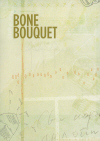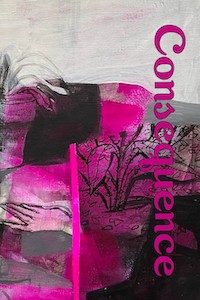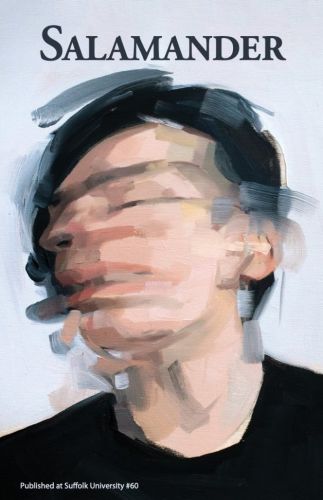The aims of Bone Bouquet’s editors have been abundantly achieved in this issue. The writers represented are women experimenting with imagery and poetic forms while at the same time exploring social agendas, dilemmas, and personal experience. Most of the selected poems subvert language and present readers with vocabulary and symbolism that confounds all expectations, expressing voices that are not often found in literary magazines.
The aims of Bone Bouquet’s editors have been abundantly achieved in this issue. The writers represented are women experimenting with imagery and poetic forms while at the same time exploring social agendas, dilemmas, and personal experience. Most of the selected poems subvert language and present readers with vocabulary and symbolism that confounds all expectations, expressing voices that are not often found in literary magazines.
In “I want to cut your hair” by Elizabeth Deanna Morris, the lines reveal desires that are outside of ordinary caring and need in a relationship. A conversation between the “I” and the “you” exposes what may or may not be wise to express:
I want to slit your finger pads
and spiral off the skin the way
you said it worked when you
had scarlet fever. . . .
The literal is not an option in this poem that hides and uncovers simultaneously.
What are readers to do with lines that challenge comprehension while sharing insight? The speaker in Stella Corso’s “Your Heart is Empty, Pal,” compares the “you” to “Serum for my casserole.” Sandy Florian’s “Big Plastics,” part of a larger work, opens with “You are inclined to make big plastics and long-range gods as well as to examine the goslings you already have.” And Liz Robbins’s “Gaffe Aftermath” begins with rain dispelling the “pollen gossip.” These images have entered a different plane of figurative language in which meaning seems to be arbitrary and yet exact. Words, lines, and stanzas have been rendered emblematic of existences that are screaming to signify meaning. In the language of semiotics, the signs in this collection of poems are not always easily determined, each poem having its own system of meaning with different signifiers, so reading each poem requires entering a new sphere of sense where what we might think we understand is different from what is real. Like Alice, we are in a state of wonder in which connotation and denotation mingle, creating a sense of confusion but also of innovation.
Of the seventeen poems in this issue, 14 are written from a first person point of view; a speaker narrates and refers to herself, and a number of the first person poems speak to another “you.” Because this is a magazine of woman writers, it might be safe to assume that the speakers in the poems are also female. This issue does not seem to include a male voice in any of the poems, with the possible exception of the piece by Amaranth Borsuk and Kate Durbin with Zach Kleyn. This two-page piece includes a pen and ink abstract collection of lines from which images emerge coupled with a page of inkblot image descriptions that may or may not fit a reader’s definition of poetry. A reader’s eyes might immediately go to the darker tinted text and read of “the bones fecund bouquet,” a “masquerade hidden,” or a “peonydaisybloodroot.” The play of language is exhilarating, invigorating, and pungent all at once. In this piece, point of view is from an outside space looking in on art that dissolves and solidifies.
Rebecca Farivar offers two minimalist poems in couplets with titles that provide a sense of disconnect thematically. In “Unprovable,” the speaker commands someone to question identity and enlightens that person to the truth: “You are less // than a second / a real person // and two / confederates.” Her poem, “Connect,” reveals a relationship in which one person requires more time alone, concluding “. . . I need / you more absent.”
Rusty Morrison’s “Its Measure” tells a timely story of an older professional woman, a victim of downsizing, forced to live in her car as she interviews for new positions. The subject of documentary, she takes pride that “Still, she has a back seat, / owns her car” and “It is / her trunk.” The most tragic revelation in the poem may be that “She still / expects.” The poem asks readers to wonder if the character of Sylvia is truly tragic or as strong as she claims.
Khadija Queen’s poem shows us someone “Overdue living the dream,” and the “real model” who “talks up her lake house friends.” The flash of the experience of the photo shoot is quick and divulging, exuberant, and poignant.
LaTasha N. Nevada Diggs’s piece has movement and energy emanating from the voices on the page. Her poem “damn right it’s betta than yours” leaves me feeling unschooled and unknowledgeable. The prosody lifts those voices, and I want to hear more.
Jill Khoury’s skillful and touching poem “The Sentence” hits all of the right notes in the song of mothers and daughters who cannot find a way to live in the world together. Khoury gives us drama without melodrama from the beginning phone call containing “The sentence / like a cartoon anvil falling / from the sky . . .” to the end when the speaker, back from third person to first, confirms the effects of hurtful words in her last two lines that reveal an overwhelming self-loathing: “The day had started out like: / I was feeling pretty.” This poem speaks to women and girls in a way that outlasts convention, with form that does not call attention to itself but accomplishes its mission: to break the reader’s heart.
Every poem in the issue contains phrases, lines, metaphors, and images that are new and baffling in their quirkiness and ambiguity and that challenge readers to change how poetry might be read silently on the page or out loud.
[www.bonebouquet.org]





